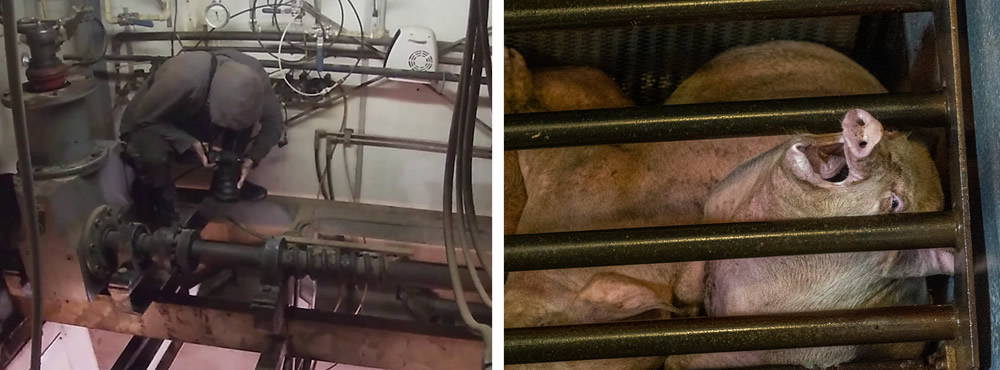News & Media > Media Releases and Statements > Activist hid inside deadly gas chamber in Victorian slaughterhouse to film horrific final moments of pigs
Activist hid inside deadly gas chamber in Victorian slaughterhouse to film horrific final moments of pigs
- Prominent animal advocate Chris Delforce hid inside one of the pork industry’s “humane” carbon dioxide gas chambers to document the gassing of pigs.
- New footage captured by Farm Transparency Project inside Victoria’s three largest slaughterhouses, revealed exclusively on ABC’s 7.30 program last night, shows thousands of pigs screaming and thrashing in agony as they are lowered into the gas.
- This investigation comes 9 years after Delforce first used hidden cameras to expose the use of gas chambers for pigs; the first time in the world that the widespread practice had been captured on camera. He says it “has only become more brutal.”

Earlier this year, activist Chris Delforce hid inside the top of a carbon dioxide gas chamber in the Australian Food Group slaughterhouse in Melbourne’s west. After filming the brutal suffocation of hundreds of pigs from just metres away, he’s now demanding a complete ban on the use of these chambers and calling out the Australian pork industry for deceptive and misleading conduct.
Delforce and his team also covertly entered Victoria’s two other largest pig slaughterhouses - Diamond Valley Pork in Laverton, and Benalla in the state’s north - and installed high-resolution hidden cameras inside the chambers. In the damning footage, revealed exclusively on ABC’s 7.30 last night, pigs are seen to scream, thrash and frantically try to escape the gas, with many still gasping and even moving around while their throats are slit.
Delforce says that, in 12 years of investigating animal cruelty, what he witnessed while hidden inside the gas chamber was “the most horrible thing I have ever seen.”
“This is not what most Australians imagine when they think about the word humane. The Australian pork industry is lying to its consumers and obscuring the reality - which is that no pig wants to die and that they go to their deaths in agony, writhing, screaming and gasping for air. Labelling this as humane is grossly deceptive and they must be held accountable by our legal system.”
Farm Transparency Project is calling on the Andrews Government to launch an inquiry into the use of carbon dioxide gas chambers in pig slaughterhouses, and pushing for a ban of the practice.
“No matter how an animal is raised, they all experience an agonising, brutal death where they fight to their very last breath. If the industry can sign off on gassing animals with the intelligence of children to death, how can we trust anything they say? The industry’s peak body, Australian Pork Limited, is refusing to even comment on this footage. That’s utterly pathetic.”
As part of the investigation, the activists needed to climb down into two of the chambers to retrieve their cameras, experiencing the painful gas first-hand.
“Even spending just ten seconds in that gas, we could feel it burning our eyes and nostrils and were instantly overcome with a sense of panic… I can’t even imagine the terror that these intelligent animals feel as they are forced into a cage and lowered to their deaths.”
Most pigs in Australia are killed inside carbon dioxide gas chambers. This process, described as “controlled atmosphere stunning” or “controlled atmosphere killing”, involves exposing a pig to high concentrations of CO2 gas until they are rendered unconscious due to asphyxiation. It only takes a few minutes inside these gas chambers for a pig to reach a point of no return where they would be unable to be revived. This practice, used by all large abattoirs in Australia, was exposed by Farm Transparency Project (then Aussie Farms) for the first time in the world back in 2014.
For more information about FTP’s campaign to Ban Gas Chambers and about the use of carbon dioxide stunning in slaughterhouses visit www.bangaschambers.com.au.
< Return to latest media releases
Sign up to receive media releases by email

 View as a PDF
View as a PDF
